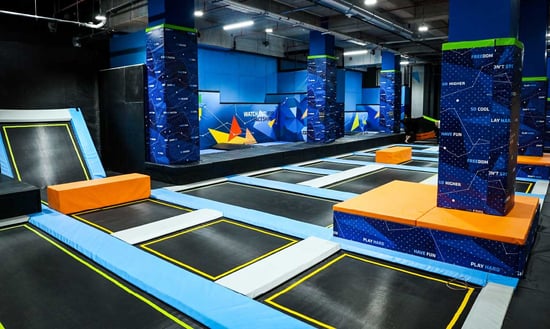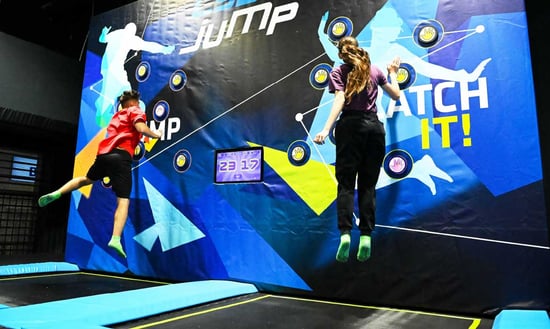Children, adolescents, and adults have endless options for entertainment in Trampoline parks. The parks feature many attractive and fun elements that are simply irresistible, which is why investing in a Trampoline park is always a good decision. But how to set the price of the ticket, and how much are visitors willing to pay for everything your Trampoline park has to offer?
Ticket sales are the main source of income for Trampoline parks
Ticket sales represent the main, profit-generating source of income for Trampoline parks. In the entertainment industry, tickets are priced depending on the time spent jumping. Most often, the price is for one hour of jumping, with package deals often available and also attracting visitors.
For this reason, tickets must be priced so as to attract
visitors again and again on the one hand while ensuring adequate
income for the Trampoline park on the other.
Ticket sales cover the costs of running a Trampoline park
When pricing a ticket, your main guide should be that ticket sales must cover all the costs and then some extra to give your earnings.
The greatest expenses of running a Trampoline park include rent, maintenance, and labor costs. In addition, there are insurance, advertising, and all the public utility costs, which have to be paid on a monthly basis.

What affects the price of a Trampoline park ticket?
It’s up to you to determine how much you’ll charge your visitors for an hour of jumping. Besides considering your competition, you should take into account several important factors that mostly relate to your costs.
1. Trampoline park location
If you put together a good business plan, you probably considered the location of the Trampoline park thoroughly while writing it. And when it comes to ticket sales, the location of your park is key.
If, for example, the Trampoline park is in an area with high rental costs, which you must cover monthly, you might have to charge a price that’s slightly higher than the average. However, if you’re located on the outskirts of a city, where rent is usually lower, you might be able to afford somewhat cheaper ticket prices.
2. Owning or renting the facility
When launching a Trampoline park, the greatest costs come from setting up a facility to function as a park. If you’re just a tenant, the rental costs must be included in the ticket prices.
If you own the building and you’ve set it up using your own funds, the price of a ticket can be a bit lower. Many people take out a loan to set up a facility or renovate an old industrial building. This means that ticket sales have to cover the costs of their monthly repayments.
3. Trampoline park insurance
Another one of the major costs that need to be covered with ticket sales is insurance. Although many think insurance is unnecessary, you’ll be faced with far greater costs in the event of damage claims. What this costs mainly depends on the type of insurance, the scope of coverage and the sum insured.

4. Trampoline park equipment
Because a visit to a Trampoline park is a lot more than just jumping on trampolines, more and more funds need to be allocated for modern equipment that will need regular renovation. And a more diverse and attractive range of services certainly warrants a slightly higher ticket price compared to the competition.
5. Number of employees
The number of employees usually depends on the size of the Trampoline park, as the staff makes sure the park functions smoothly. Pricing tickets appropriately will cover staff salaries, so be sure to thoroughly calculate the costs associated with these, as well as any related insurance and payment of all contributions.
Here, you should pay particular attention to any special skills the staff must have to perform specific tasks and the need for continuous education.
6. Advertising
When pricing your tickets, think carefully about the type of advertising you want to go for. Will you do the advertising yourself, or hire an agency? Which channels will you use and how much are you prepared to invest in advertising? All this will greatly affect the costs that need to be covered with ticket sales, so you should think about this in advance.
7. Maintenance
The funds from ticket sales also go towards maintaining the Trampoline park. Regular maintenance is extremely important to ensure safety. It’s vital that repairs are done as soon as you discover a trampoline has been damaged. As the owner of a Trampoline park, you cannot afford a lack of repair funds, as the non-operation of a trampoline will cause you a further loss.

8. The size of the Trampoline park
The size of your Trampoline park is what ultimately determines how many visitors can use it simultaneously. The larger the park, the greater capacity it offers. The size also tells you how many tickets you can sell at one time.
The fact of the matter is that profit is essential when it comes to successfully running a Trampoline park, and it can only be achieved by pricing your tickets well. Be sure to also keep in mind all the birthday parties, special occasions, and team-building events that your park could host, which can present a great opportunity for extra income.
What if you could manage and control your trampoline park direct from your smartphone or other devices? Download our FREE e-Book now and find out about the Smart Park Solution for your Trampoline park.

